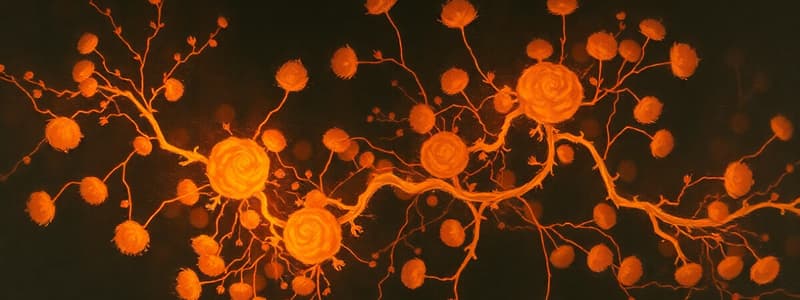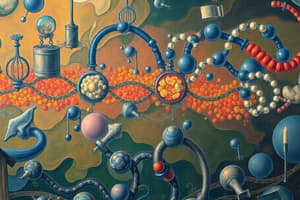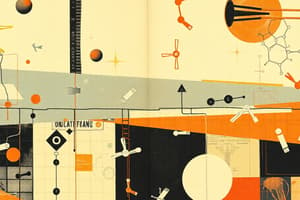Podcast
Questions and Answers
What is the net energy gain from aerobic glycolysis?
What is the net energy gain from aerobic glycolysis?
- 10 ATP
- 4 ATP
- 2 ATP
- 6-8 ATP (correct)
Which enzyme is NOT one of the key irreversible enzymes of glycolysis?
Which enzyme is NOT one of the key irreversible enzymes of glycolysis?
- Hexokinase
- Pyruvate kinase
- Phosphofructokinase-1
- Lactate dehydrogenase (correct)
What is the primary end product of glycolysis in mature red blood cells?
What is the primary end product of glycolysis in mature red blood cells?
- Ethanol
- Pyruvate
- Acetyl-CoA
- Lactate (correct)
How does insulin affect the synthesis of key glycolytic enzymes?
How does insulin affect the synthesis of key glycolytic enzymes?
Which of the following statements is true regarding 2,3 biphosphoglycerate in red blood cells?
Which of the following statements is true regarding 2,3 biphosphoglycerate in red blood cells?
Which of the following regulates phosphofructokinase-1 (PFK-1) through allosteric modulation?
Which of the following regulates phosphofructokinase-1 (PFK-1) through allosteric modulation?
What is the consequence of phosphorylating pyruvate kinase?
What is the consequence of phosphorylating pyruvate kinase?
During anaerobic glycolysis, what happens to the 2 NADH produced?
During anaerobic glycolysis, what happens to the 2 NADH produced?
What is the primary consequence of the absence of intestinal lactase?
What is the primary consequence of the absence of intestinal lactase?
Which pathway specifically produces pyruvate as a byproduct?
Which pathway specifically produces pyruvate as a byproduct?
What is the net energy yield from anaerobic glycolysis?
What is the net energy yield from anaerobic glycolysis?
Which statement correctly describes the energy-requiring step of glycolysis?
Which statement correctly describes the energy-requiring step of glycolysis?
Which of the following tissues is most reliant on glycolysis due to its lack of mitochondria?
Which of the following tissues is most reliant on glycolysis due to its lack of mitochondria?
What role does 2,3-bisphosphoglycerate play in the body?
What role does 2,3-bisphosphoglycerate play in the body?
Which is a characteristic of the citric acid cycle in terms of metabolic pathways?
Which is a characteristic of the citric acid cycle in terms of metabolic pathways?
What is the metabolic significance of dihydroxyacetone phosphate in glycolysis?
What is the metabolic significance of dihydroxyacetone phosphate in glycolysis?
What is the primary function of anabolic pathways in metabolism?
What is the primary function of anabolic pathways in metabolism?
Which enzyme converts dextrins into maltose during carbohydrate metabolism?
Which enzyme converts dextrins into maltose during carbohydrate metabolism?
Which of the following best describes catabolic pathways?
Which of the following best describes catabolic pathways?
What role do amphibolic pathways play in metabolism?
What role do amphibolic pathways play in metabolism?
Which carbohydrate source constitutes the majority of dietary carbohydrates?
Which carbohydrate source constitutes the majority of dietary carbohydrates?
What is the consequence of a deficiency in lactase enzyme?
What is the consequence of a deficiency in lactase enzyme?
How much energy is released from the complete oxidation of 1 gram of carbohydrate?
How much energy is released from the complete oxidation of 1 gram of carbohydrate?
Which of the following statements regarding carbohydrate digestion is true?
Which of the following statements regarding carbohydrate digestion is true?
Flashcards
Metabolism
Metabolism
The chemical reactions in the body that involve the synthesis and breakdown of substances.
Anabolic pathways
Anabolic pathways
Build complex molecules from simpler ones; require energy.
Catabolic pathways
Catabolic pathways
Break down complex molecules into simpler ones; release energy.
Amphibolic pathways
Amphibolic pathways
Signup and view all the flashcards
Carbohydrate metabolism
Carbohydrate metabolism
Signup and view all the flashcards
CHO source
CHO source
Signup and view all the flashcards
Digestion of CHO
Digestion of CHO
Signup and view all the flashcards
Salivary amylase
Salivary amylase
Signup and view all the flashcards
Pancreatic amylase
Pancreatic amylase
Signup and view all the flashcards
Intestinal disaccharidases
Intestinal disaccharidases
Signup and view all the flashcards
Lactose intolerance
Lactose intolerance
Signup and view all the flashcards
Lactose Intolerance
Lactose Intolerance
Signup and view all the flashcards
Symptoms of Lactose Intolerance
Symptoms of Lactose Intolerance
Signup and view all the flashcards
Glycolysis
Glycolysis
Signup and view all the flashcards
Glycolysis Location
Glycolysis Location
Signup and view all the flashcards
Aerobic Glycolysis
Aerobic Glycolysis
Signup and view all the flashcards
Anaerobic Glycolysis
Anaerobic Glycolysis
Signup and view all the flashcards
Glycolysis Stages
Glycolysis Stages
Signup and view all the flashcards
Glycolysis Importance
Glycolysis Importance
Signup and view all the flashcards
ATP Consumption in Glycolysis
ATP Consumption in Glycolysis
Signup and view all the flashcards
ATP Production in Aerobic Glycolysis
ATP Production in Aerobic Glycolysis
Signup and view all the flashcards
Substrate-level phosphorylation
Substrate-level phosphorylation
Signup and view all the flashcards
Aerobic glycolysis ATP gain
Aerobic glycolysis ATP gain
Signup and view all the flashcards
Anaerobic glycolysis ATP gain
Anaerobic glycolysis ATP gain
Signup and view all the flashcards
RBC Energy Production
RBC Energy Production
Signup and view all the flashcards
RBC Glucose Uptake
RBC Glucose Uptake
Signup and view all the flashcards
2,3-BPG Production
2,3-BPG Production
Signup and view all the flashcards
Glycolysis Key Enzymes
Glycolysis Key Enzymes
Signup and view all the flashcards
Hormonal Regulation of Glycolysis
Hormonal Regulation of Glycolysis
Signup and view all the flashcards
Allosteric Regulation (Glycolysis)
Allosteric Regulation (Glycolysis)
Signup and view all the flashcards
Fructose 2,6-bisphosphate
Fructose 2,6-bisphosphate
Signup and view all the flashcards
Study Notes
CHO Metabolism
- CHO metabolism is the study of how the body processes carbohydrates.
- It involves the fate of food molecules after digestion and absorption.
- It's a series of chemical and enzymatic reactions within the body, encompassing synthesis and breakdown of various substances.
Metabolic Pathways
- Anabolic pathways: Synthesize complex molecules from simpler ones, requiring energy.
- Example: Protein synthesis
- Catabolic pathways: Break down complex molecules into simpler ones, releasing energy.
- Example: Oxidative processes
- Amphibolic pathways: Act as links between anabolic and catabolic pathways.
- Example: Citric acid cycle
Carbohydrate Metabolism
- Carbohydrates provide 50% of daily calories.
- Complete oxidation of 1 gram of carbs yields 4 kcal.
- Sources of Carbohydrates (CHO) in food:
- Starch (50%, e.g., potatoes)
- Sucrose and lactose (remainder)
- Fructose and glucose (fruits, honey)
Digestion of CHO
- Polysaccharides and disaccharides must be broken down into monosaccharides for absorption.
- Enzymes involved:
- Salivary amylase: Breaks down starch and glycogen into dextrins.
- Pancreatic amylase: Breaks down dextrins into maltose.
- Intestinal disaccharidases:
- Maltase: Converts maltose into glucose.
- Sucrase: Converts sucrose into glucose and fructose.
- Lactase: Converts lactose into glucose and galactose.
Lactose Intolerance
- Definition: A condition where lactase enzyme is deficient, leading to lactose not being digested.
- Cause: Deficiency of lactase enzyme.
- Effects:
- Lactose accumulates in the intestine.
- Fermentation by intestinal bacteria.
- Production of acids and gases.
- Symptoms: Abdominal distension, cramps, and diarrhea.
- Treatment: Lactose-free milk formula.
Metabolic Pathways of Carbohydrates
- Catabolic pathways:
- Glycolysis
- Hexose monophosphate shunt
- Uronic acid pathway
- Glycogenolysis
- Anabolic pathways:
- Gluconeogenesis
- Glycogenesis
- Amphibolic pathways:
- Citric acid cycle
Glycolysis
- Definition: Oxidation of glucose to pyruvate in the presence of oxygen, or lactate in the absence.
- Major pathway of glucose oxidation.
- Site: Cytoplasm of all cells, with specific importance in:
- Cells lacking mitochondria (e.g., red blood cells)
- Tissues with frequent oxygen lack (e.g., skeletal muscles during exercise).
- Steps:
- Stage 1: Energy-requiring step (glucose converted to glyceraldehyde-3-P).
- Stage 2: Energy-producing step (glyceraldehyde-3-P converted to pyruvate or lactate).
Glycolysis in Red Blood Cells
- Mature RBCs lack mitochondria, relying solely on glycolysis.
- Lactate is the final product.
- Net energy yield: 2 ATP.
- Glucose uptake is independent of insulin.
- Critical in producing 2,3-biphosphoglycerate.
Regulation of Glycolysis
- Key enzymes (irreversible): Hexokinase/glucokinase, Phosphofructokinase-1 (PFK-1), Pyruvate kinase
- Hormonal regulation: Insulin promotes synthesis, glucagon inhibits.
- Allosteric regulation:
- G-6-P inhibits hexokinase (not glucokinase).
- Fructose 2,6-bisphosphate stimulates PFK-1.
- Citrate inhibits PFK-1.
- Fructose 2,6-bisphosphate stimulates pyruvate kinase.
- Covalent modification: Pyruvate kinase is inactivated by phosphorylation.
- Energy regulation: ADP and AMP stimulate PFK-1; ATP inhibits PFK-1 and pyruvate kinase
In Vitro Inhibition of Glycolysis
- Inhibitors:
- Arsenate (competes with inorganic phosphate).
- Iodoacetate (inhibits glyceraldehyde-3-phosphate dehydrogenase).
- Fluoride (inhibits enolase).
- Clinical significance: Hemolytic anemia may result from insufficient pyruvate kinase activity in red blood cells.
Energy Production of Glycolysis
- ATP consumption (both aerobic and anaerobic): 1 ATP for converting glucose to G-6-P, 1 ATP for converting fructose-6-P to fructose 1,6 biphosphate. Net energy consumed: 2 ATP.
- ATP production (aerobic glycolysis):
- 4 ATP by substrate-level phosphorylation (e.g., conversion of 1,3-biphosphoglycerate to 3-phosphoglycerate).
- Other ATP from oxidative phosphorylation in mitochondria (from NADH). (either 4 or 6 ATP)
- ATP production (anaerobic glycolysis): 2 ATP by substrate-level phosphorylation.
Substrate-level phosphorylation
- Direct transfer of a phosphate group from a high-energy molecule to ADP.
Studying That Suits You
Use AI to generate personalized quizzes and flashcards to suit your learning preferences.



